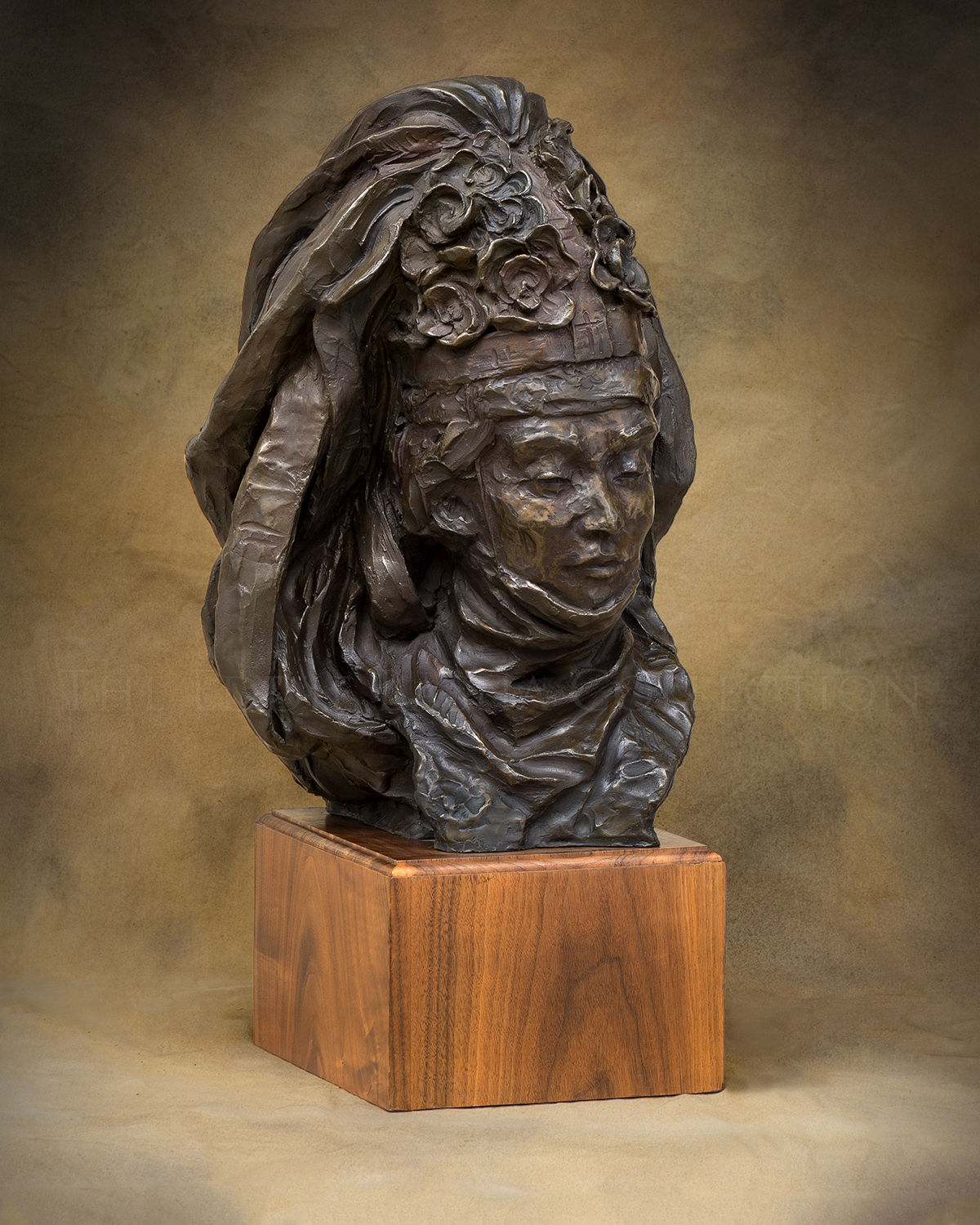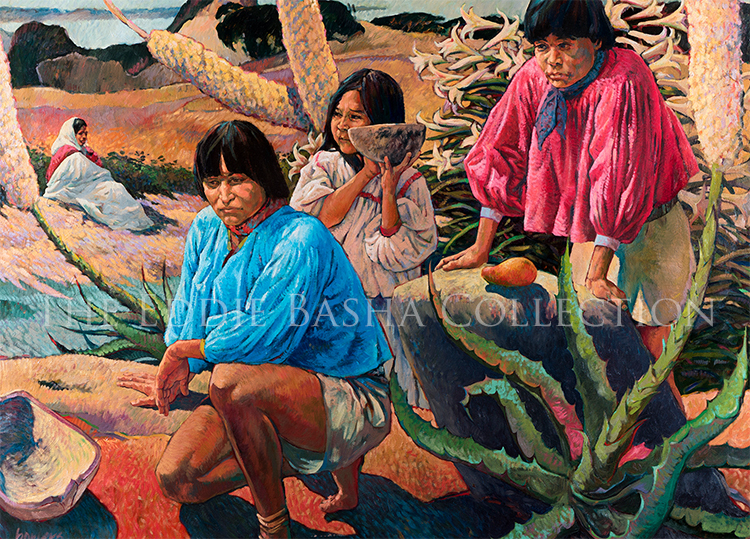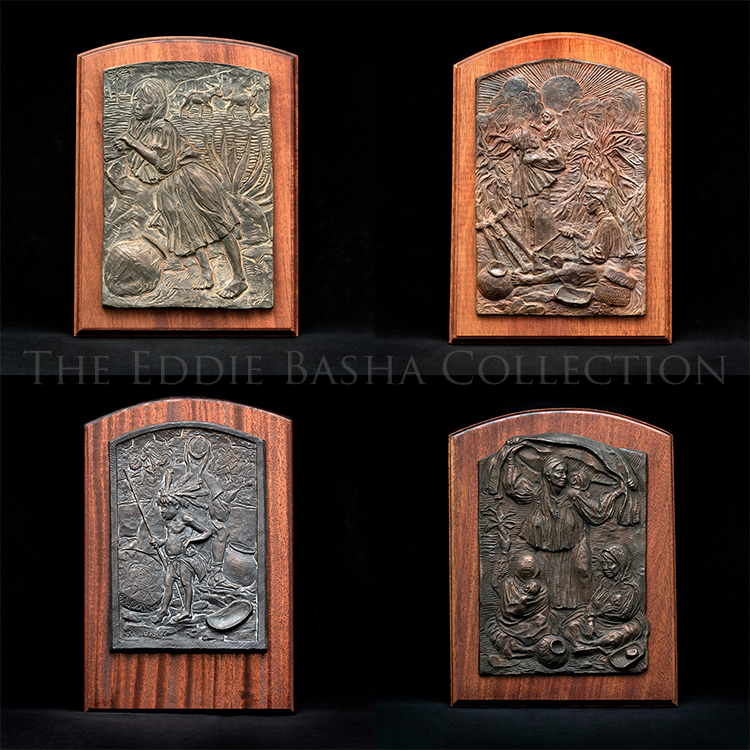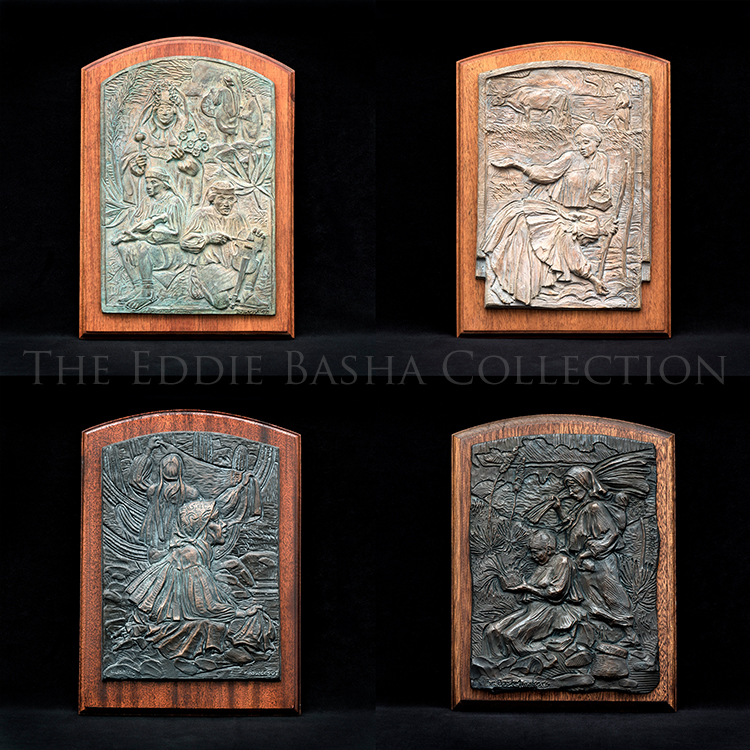
Russell Bowers
(b.1952)
Mr. Bowers currently resides in Mesa, Arizona, but often travels to Mexico to execute watercolors of the area. He created an “Arizona Collection” of paintings completed in December 1981. This artist had exhibited his work at Main Trail Galleries in Scottsdale as well as the Sanders Gallery in Tucson, Arizona.
He also produces figurative bronze castings. One of these of a small boy (1996) is part of Tempe’s public art program and is positioned at Grove Parkway Plaza.
Russell Bowers was commisioned to create an artwork consisting of three bronze figures as a monument to the work and efforts of the Chandler Police Department in Arizona. This bronze artwork reminds us of the dedication and honor of Chandler’s Police force. The artwork is sited in the plaze in front of the Chandler Police Department administration building.
Source: Savvy Collector

Tarahumara Matachin Bust
Artist: Russ Bowers (b.1952)
Description: Bronze | Dimensions: 26”h X 13”w x 12”dbronze
Arizona native, legislator and artist, Russell “Rusty” Bowers, has travelled numerous times to visit his friends, the Tarahumara, who are often the subject matter of his paintings and sculptures. As a young man, he served his LDS mission in the region. Upon his return he got his Bachelor’s Degree in Fine Arts at BYU.
The Tarahumara are inhabitants of Copper Canyon, otherwise known as the Sierra Tarahumara in northwest Mexico. The actual name Tarahumara was what the first Spanish called these indigenous peoples when first encountered in the 1500’s in Chihuahua. The encroachment of the Spanish as well as the discovery of mineral wealth that was thrust upon their private-by-nature existence caused their retreat into the harder to reach canyon areas. Today, they are Mexico’s second largest native Indian group with between 50,000-70,000 people. They live simply in caves, under cliffs and in small wood or stone cabins in remote areas and are undisturbed by modern technology. The Tarahumara are legendary runners and surprise most with their agility and speed because of their tire-soled sandals. Running is not only a tradition but a necessity since the small communities are often far apart and it is the only mode of transportation. Music and dance also play a significant role in Tarahumara culture. During the end of the year cycle, they play beautifully carved, yet unvarnished, violins. Their songs are known as matachin pieces and the dancers are dressed in colorful attire which resemble North African garments and head pieces similar to those seen in this bronze bust.
Unknown Title
Artist: Russ Bowers (b.1952)
Description: Oil | Image Size: 36”h x 50”w; Framed Size: 47”h x 61”wpainting
This large painting of Tarahumara Indians is a bold expression of bright colors and botanical shapes. Three figures dominate the canvas, two older men and one young girl, who are harvesting crops in front of a large blooming cactus with another behind them. A large green yucca anchors the right corner of the painting and a woman wearing her elegant, yet multi-purpose rebozo can be seen watching the workers from a distance on the left. The brightly-colored clothing and expressive faces highlight the painting. It is well composed and has a vibrant nature reflective of both the land and people portrayed.
Tarahumara People
Artist: Russ Bowers (b.1952)
Description: Bronze Reliefsbronze
Throughout the years, Eddie was fond of sharing his love and appreciation for art. And if an artist was helped in the process, Eddie was happy he could in some small measure be of assistance. One of those collaborations was with Arizona native, legislator and artist, Russell “Rusty” Bowers. Over an eight year period, Russ sculpted eight bronze reliefs depicting various aspects of the Tarahumara Indian people and its culture. Eddie would purchase several reliefs and share those masterworks with friends and colleagues. Of course one of each remains a part of the permanent collection. We hope you enjoy the reliefs we’re sharing with you today and tomorrow.
As a young man, Bowers served his LDS mission in the region. Upon his return he got his Bachelor’s Degree in Fine Arts at BYU. The Tarahumara are inhabitants of Copper Canyon, otherwise known as the Sierra Tarahumara in northwest Mexico. The actual name Tarahumara was what the first Spanish called these Native American people when first encountered in the 1500’s in Chihuahua. The encroachment of the Spanish as well as the discovery of mineral wealth that was thrust upon their private-by-nature existence caused their retreat into the harder to reach canyon areas. Today, they are Mexico’s second largest native Indian group with between 50,000 – 70,000 people. They live simply in caves, under cliffs and in small wood or stone cabins in remote areas and are undisturbed by modern technology. The Tarahumara are legendary runners and surprise most with their agility and speed because of their tire-soled sandals. Running is not only a tradition but a necessity since the small communities are often far apart and it is the only mode of transportation. Music and dance also play a significant role in Tarahumara culture. During the end of the year cycle, they play beautifully carved, yet unvarnished, violins. Their songs are known as matachin pieces and the dancers are dressed in colorful attire which resemble North African garments and head pieces.
Tarahumara People
Artist: Russ Bowers (b.1952)
Description: Bronze Reliefsbronze
Throughout the years, Eddie was fond of sharing his love and appreciation for art. And if an artist was helped in the process, Eddie was happy he could in some small measure be of assistance. One of those collaborations was with Arizona native, legislator and artist, Russell “Rusty” Bowers. Over an eight year period, Russ sculpted eight bronze reliefs depicting various aspects of the Tarahumara Indian people and its culture. Eddie would purchase several reliefs and share those masterworks with friends and colleagues. Of course one of each remains a part of the permanent collection. We hope you enjoy the reliefs we’re sharing with you today and tomorrow.
As a young man, Bowers served his LDS mission in the region. Upon his return he got his Bachelor’s Degree in Fine Arts at BYU. The Tarahumara are inhabitants of Copper Canyon, otherwise known as the Sierra Tarahumara in northwest Mexico. The actual name Tarahumara was what the first Spanish called these Native American people when first encountered in the 1500’s in Chihuahua. The encroachment of the Spanish as well as the discovery of mineral wealth that was thrust upon their private-by-nature existence caused their retreat into the harder to reach canyon areas. Today, they are Mexico’s second largest native Indian group with between 50,000 – 70,000 people. They live simply in caves, under cliffs and in small wood or stone cabins in remote areas and are undisturbed by modern technology. The Tarahumara are legendary runners and surprise most with their agility and speed because of their tire-soled sandals. Running is not only a tradition but a necessity since the small communities are often far apart and it is the only mode of transportation. Music and dance also play a significant role in Tarahumara culture. During the end of the year cycle, they play beautifully carved, yet unvarnished, violins. Their songs are known as matachin pieces and the dancers are dressed in colorful attire which resemble North African garments and head pieces.
 Bronze | Dimensions: 26”h X 13”w x 12”d
Bronze | Dimensions: 26”h X 13”w x 12”dArizona native, legislator and artist, Russell “Rusty” Bowers, has travelled numerous times to visit his friends, the Tarahumara, who are often the subject matter of his paintings and sculptures. As a young man, he served his LDS mission in the region. Upon his return he got his Bachelor’s Degree in Fine Arts at BYU.
The Tarahumara are inhabitants of Copper Canyon, otherwise known as the Sierra Tarahumara in northwest Mexico. The actual name Tarahumara was what the first Spanish called these indigenous peoples when first encountered in the 1500’s in Chihuahua. The encroachment of the Spanish as well as the discovery of mineral wealth that was thrust upon their private-by-nature existence caused their retreat into the harder to reach canyon areas. Today, they are Mexico’s second largest native Indian group with between 50,000-70,000 people. They live simply in caves, under cliffs and in small wood or stone cabins in remote areas and are undisturbed by modern technology. The Tarahumara are legendary runners and surprise most with their agility and speed because of their tire-soled sandals. Running is not only a tradition but a necessity since the small communities are often far apart and it is the only mode of transportation. Music and dance also play a significant role in Tarahumara culture. During the end of the year cycle, they play beautifully carved, yet unvarnished, violins. Their songs are known as matachin pieces and the dancers are dressed in colorful attire which resemble North African garments and head pieces similar to those seen in this bronze bust.
Tarahumara Matachin Bust
Artist: Russ Bowers (b.1952)
Arizona native, legislator and artist, Russell “Rusty” Bowers, has travelled numerous times to visit his friends, the Tarahumara, who are often the subject matter of his paintings and sculptures. As a young man, he served his LDS mission in the region. Upon his return he got his Bachelor’s Degree in Fine Arts at BYU.
The Tarahumara are inhabitants of Copper Canyon, otherwise known as the Sierra Tarahumara in northwest Mexico. The actual name Tarahumara was what the first Spanish called these indigenous peoples when first encountered in the 1500’s in Chihuahua. The encroachment of the Spanish as well as the discovery of mineral wealth that was thrust upon their private-by-nature existence caused their retreat into the harder to reach canyon areas. Today, they are Mexico’s second largest native Indian group with between 50,000-70,000 people. They live simply in caves, under cliffs and in small wood or stone cabins in remote areas and are undisturbed by modern technology. The Tarahumara are legendary runners and surprise most with their agility and speed because of their tire-soled sandals. Running is not only a tradition but a necessity since the small communities are often far apart and it is the only mode of transportation. Music and dance also play a significant role in Tarahumara culture. During the end of the year cycle, they play beautifully carved, yet unvarnished, violins. Their songs are known as matachin pieces and the dancers are dressed in colorful attire which resemble North African garments and head pieces similar to those seen in this bronze bust.
 Oil | Image Size: 36”h x 50”w; Framed Size: 47”h x 61”w
Oil | Image Size: 36”h x 50”w; Framed Size: 47”h x 61”wThis large painting of Tarahumara Indians is a bold expression of bright colors and botanical shapes. Three figures dominate the canvas, two older men and one young girl, who are harvesting crops in front of a large blooming cactus with another behind them. A large green yucca anchors the right corner of the painting and a woman wearing her elegant, yet multi-purpose rebozo can be seen watching the workers from a distance on the left. The brightly-colored clothing and expressive faces highlight the painting. It is well composed and has a vibrant nature reflective of both the land and people portrayed.
Unknown Title
Artist: Russ Bowers (b.1952)
This large painting of Tarahumara Indians is a bold expression of bright colors and botanical shapes. Three figures dominate the canvas, two older men and one young girl, who are harvesting crops in front of a large blooming cactus with another behind them. A large green yucca anchors the right corner of the painting and a woman wearing her elegant, yet multi-purpose rebozo can be seen watching the workers from a distance on the left. The brightly-colored clothing and expressive faces highlight the painting. It is well composed and has a vibrant nature reflective of both the land and people portrayed.
 Bronze Reliefs
Bronze ReliefsThroughout the years, Eddie was fond of sharing his love and appreciation for art. And if an artist was helped in the process, Eddie was happy he could in some small measure be of assistance. One of those collaborations was with Arizona native, legislator and artist, Russell “Rusty” Bowers. Over an eight year period, Russ sculpted eight bronze reliefs depicting various aspects of the Tarahumara Indian people and its culture. Eddie would purchase several reliefs and share those masterworks with friends and colleagues. Of course one of each remains a part of the permanent collection. We hope you enjoy the reliefs we’re sharing with you today and tomorrow.
As a young man, Bowers served his LDS mission in the region. Upon his return he got his Bachelor’s Degree in Fine Arts at BYU. The Tarahumara are inhabitants of Copper Canyon, otherwise known as the Sierra Tarahumara in northwest Mexico. The actual name Tarahumara was what the first Spanish called these Native American people when first encountered in the 1500’s in Chihuahua. The encroachment of the Spanish as well as the discovery of mineral wealth that was thrust upon their private-by-nature existence caused their retreat into the harder to reach canyon areas. Today, they are Mexico’s second largest native Indian group with between 50,000 – 70,000 people. They live simply in caves, under cliffs and in small wood or stone cabins in remote areas and are undisturbed by modern technology. The Tarahumara are legendary runners and surprise most with their agility and speed because of their tire-soled sandals. Running is not only a tradition but a necessity since the small communities are often far apart and it is the only mode of transportation. Music and dance also play a significant role in Tarahumara culture. During the end of the year cycle, they play beautifully carved, yet unvarnished, violins. Their songs are known as matachin pieces and the dancers are dressed in colorful attire which resemble North African garments and head pieces.
Tarahumara People
Artist: Russ Bowers (b.1952)
Throughout the years, Eddie was fond of sharing his love and appreciation for art. And if an artist was helped in the process, Eddie was happy he could in some small measure be of assistance. One of those collaborations was with Arizona native, legislator and artist, Russell “Rusty” Bowers. Over an eight year period, Russ sculpted eight bronze reliefs depicting various aspects of the Tarahumara Indian people and its culture. Eddie would purchase several reliefs and share those masterworks with friends and colleagues. Of course one of each remains a part of the permanent collection. We hope you enjoy the reliefs we’re sharing with you today and tomorrow.
As a young man, Bowers served his LDS mission in the region. Upon his return he got his Bachelor’s Degree in Fine Arts at BYU. The Tarahumara are inhabitants of Copper Canyon, otherwise known as the Sierra Tarahumara in northwest Mexico. The actual name Tarahumara was what the first Spanish called these Native American people when first encountered in the 1500’s in Chihuahua. The encroachment of the Spanish as well as the discovery of mineral wealth that was thrust upon their private-by-nature existence caused their retreat into the harder to reach canyon areas. Today, they are Mexico’s second largest native Indian group with between 50,000 – 70,000 people. They live simply in caves, under cliffs and in small wood or stone cabins in remote areas and are undisturbed by modern technology. The Tarahumara are legendary runners and surprise most with their agility and speed because of their tire-soled sandals. Running is not only a tradition but a necessity since the small communities are often far apart and it is the only mode of transportation. Music and dance also play a significant role in Tarahumara culture. During the end of the year cycle, they play beautifully carved, yet unvarnished, violins. Their songs are known as matachin pieces and the dancers are dressed in colorful attire which resemble North African garments and head pieces.
 Bronze Reliefs
Bronze ReliefsThroughout the years, Eddie was fond of sharing his love and appreciation for art. And if an artist was helped in the process, Eddie was happy he could in some small measure be of assistance. One of those collaborations was with Arizona native, legislator and artist, Russell “Rusty” Bowers. Over an eight year period, Russ sculpted eight bronze reliefs depicting various aspects of the Tarahumara Indian people and its culture. Eddie would purchase several reliefs and share those masterworks with friends and colleagues. Of course one of each remains a part of the permanent collection. We hope you enjoy the reliefs we’re sharing with you today and tomorrow.
As a young man, Bowers served his LDS mission in the region. Upon his return he got his Bachelor’s Degree in Fine Arts at BYU. The Tarahumara are inhabitants of Copper Canyon, otherwise known as the Sierra Tarahumara in northwest Mexico. The actual name Tarahumara was what the first Spanish called these Native American people when first encountered in the 1500’s in Chihuahua. The encroachment of the Spanish as well as the discovery of mineral wealth that was thrust upon their private-by-nature existence caused their retreat into the harder to reach canyon areas. Today, they are Mexico’s second largest native Indian group with between 50,000 – 70,000 people. They live simply in caves, under cliffs and in small wood or stone cabins in remote areas and are undisturbed by modern technology. The Tarahumara are legendary runners and surprise most with their agility and speed because of their tire-soled sandals. Running is not only a tradition but a necessity since the small communities are often far apart and it is the only mode of transportation. Music and dance also play a significant role in Tarahumara culture. During the end of the year cycle, they play beautifully carved, yet unvarnished, violins. Their songs are known as matachin pieces and the dancers are dressed in colorful attire which resemble North African garments and head pieces.
Tarahumara People
Artist: Russ Bowers (b.1952)
Throughout the years, Eddie was fond of sharing his love and appreciation for art. And if an artist was helped in the process, Eddie was happy he could in some small measure be of assistance. One of those collaborations was with Arizona native, legislator and artist, Russell “Rusty” Bowers. Over an eight year period, Russ sculpted eight bronze reliefs depicting various aspects of the Tarahumara Indian people and its culture. Eddie would purchase several reliefs and share those masterworks with friends and colleagues. Of course one of each remains a part of the permanent collection. We hope you enjoy the reliefs we’re sharing with you today and tomorrow.
As a young man, Bowers served his LDS mission in the region. Upon his return he got his Bachelor’s Degree in Fine Arts at BYU. The Tarahumara are inhabitants of Copper Canyon, otherwise known as the Sierra Tarahumara in northwest Mexico. The actual name Tarahumara was what the first Spanish called these Native American people when first encountered in the 1500’s in Chihuahua. The encroachment of the Spanish as well as the discovery of mineral wealth that was thrust upon their private-by-nature existence caused their retreat into the harder to reach canyon areas. Today, they are Mexico’s second largest native Indian group with between 50,000 – 70,000 people. They live simply in caves, under cliffs and in small wood or stone cabins in remote areas and are undisturbed by modern technology. The Tarahumara are legendary runners and surprise most with their agility and speed because of their tire-soled sandals. Running is not only a tradition but a necessity since the small communities are often far apart and it is the only mode of transportation. Music and dance also play a significant role in Tarahumara culture. During the end of the year cycle, they play beautifully carved, yet unvarnished, violins. Their songs are known as matachin pieces and the dancers are dressed in colorful attire which resemble North African garments and head pieces.